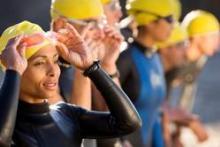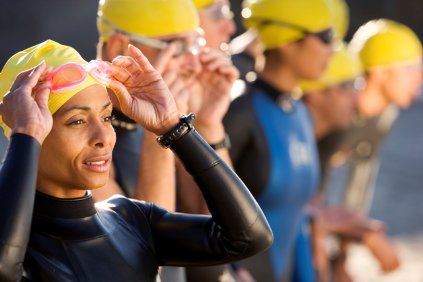User login
WASHINGTON – A large proportion of female triathletes who responded to a national Web-based survey have symptoms of pelvic floor disorders, and one in four screened positive for the female athlete triad.
These findings from women in the general population, with a median age range of 35-44 years, echo findings from studies of Olympic and professional athletes, and "show that even young, thin, and otherwise healthy endurance athletes [who are not professional athletes] have pelvic floor disorders," said Dr. Johnny Yi after presenting his findings in a press conference at the scientific meetings of the American Urogynecologic Society and the International Urogynecological Association.
Currently, "these women may not get screened because they are not believed to be in a high-risk group," said Dr. Yi, a urogynecologist in group practice in Denver.
Of 311 women who responded to the survey, 37% reported symptoms of stress urinary incontinence, and 16% reported symptoms of urgency urinary incontinence. Anal incontinence was also a problem, with 37% reporting symptoms of this condition. Pelvic organ prolapse symptoms were reported by 5%.
Most of the participants were white (90%), nonsmokers (99%), and premenopausal (80%), and had a mean body mass index of 22 kg/m2. About half had borne children, almost all of them had vaginal deliveries.
The women were invited to participate through a database of nationwide triathlon interest groups and a triathlete Internet forum. The survey included the Epidemiology of Prolapse and Incontinence Questionnaire (EPIQ) and the Pelvic Girdle Pain Questionnaire (PGPQ), both of which are validated tools; the Female Athlete Triad Screening Questionnaire, which is endorsed by the National Collegiate Athletic Association; and various medical and demographic questions.
Approximately 18% of the women had pelvic girdle pain, although the mean score on the PGPQ (35.6) was relatively low. Respondents with various types of incontinence reported higher levels of pelvic girdle pain, Dr. Yi said.
Of the 75% of respondents who completed the triad questionnaire, 22% screened positive for low energy availability, 24% for menstrual irregularities, and 29% for abnormal bone strength. Eight percent screened positive for all three components of the female athlete triad, which is characterized by a hypoestrogenic state similar to menopause.
Dr. Yi said he is particularly interested in possible associations between the female athlete triad and pelvic floor disorders, and in the pelvic floor consequences of coupling high-impact, high-endurance activity with the potential for a hypoestrogenic state.
This study showed no significant association between the triad and pelvic floor disorders, but the findings emphasize that "both disorders are prevalent" and should be screened for and treated to avoid long-term sequelae and improve quality of life, he said.
Weekly training of the study participants consisted of running for a mean of 3.7 days, biking for a mean of 2.9 days, and swimming for a mean of 2.4 days. Training mileage and intensity were not associated with pelvic floor disorders. Not unexpectedly, parity was associated with a higher prevalence of stress urinary incontinence and pelvic organ prolapse.
Dr. Yi and his coinvestigators reported no disclosures.
WASHINGTON – A large proportion of female triathletes who responded to a national Web-based survey have symptoms of pelvic floor disorders, and one in four screened positive for the female athlete triad.
These findings from women in the general population, with a median age range of 35-44 years, echo findings from studies of Olympic and professional athletes, and "show that even young, thin, and otherwise healthy endurance athletes [who are not professional athletes] have pelvic floor disorders," said Dr. Johnny Yi after presenting his findings in a press conference at the scientific meetings of the American Urogynecologic Society and the International Urogynecological Association.
Currently, "these women may not get screened because they are not believed to be in a high-risk group," said Dr. Yi, a urogynecologist in group practice in Denver.
Of 311 women who responded to the survey, 37% reported symptoms of stress urinary incontinence, and 16% reported symptoms of urgency urinary incontinence. Anal incontinence was also a problem, with 37% reporting symptoms of this condition. Pelvic organ prolapse symptoms were reported by 5%.
Most of the participants were white (90%), nonsmokers (99%), and premenopausal (80%), and had a mean body mass index of 22 kg/m2. About half had borne children, almost all of them had vaginal deliveries.
The women were invited to participate through a database of nationwide triathlon interest groups and a triathlete Internet forum. The survey included the Epidemiology of Prolapse and Incontinence Questionnaire (EPIQ) and the Pelvic Girdle Pain Questionnaire (PGPQ), both of which are validated tools; the Female Athlete Triad Screening Questionnaire, which is endorsed by the National Collegiate Athletic Association; and various medical and demographic questions.
Approximately 18% of the women had pelvic girdle pain, although the mean score on the PGPQ (35.6) was relatively low. Respondents with various types of incontinence reported higher levels of pelvic girdle pain, Dr. Yi said.
Of the 75% of respondents who completed the triad questionnaire, 22% screened positive for low energy availability, 24% for menstrual irregularities, and 29% for abnormal bone strength. Eight percent screened positive for all three components of the female athlete triad, which is characterized by a hypoestrogenic state similar to menopause.
Dr. Yi said he is particularly interested in possible associations between the female athlete triad and pelvic floor disorders, and in the pelvic floor consequences of coupling high-impact, high-endurance activity with the potential for a hypoestrogenic state.
This study showed no significant association between the triad and pelvic floor disorders, but the findings emphasize that "both disorders are prevalent" and should be screened for and treated to avoid long-term sequelae and improve quality of life, he said.
Weekly training of the study participants consisted of running for a mean of 3.7 days, biking for a mean of 2.9 days, and swimming for a mean of 2.4 days. Training mileage and intensity were not associated with pelvic floor disorders. Not unexpectedly, parity was associated with a higher prevalence of stress urinary incontinence and pelvic organ prolapse.
Dr. Yi and his coinvestigators reported no disclosures.
WASHINGTON – A large proportion of female triathletes who responded to a national Web-based survey have symptoms of pelvic floor disorders, and one in four screened positive for the female athlete triad.
These findings from women in the general population, with a median age range of 35-44 years, echo findings from studies of Olympic and professional athletes, and "show that even young, thin, and otherwise healthy endurance athletes [who are not professional athletes] have pelvic floor disorders," said Dr. Johnny Yi after presenting his findings in a press conference at the scientific meetings of the American Urogynecologic Society and the International Urogynecological Association.
Currently, "these women may not get screened because they are not believed to be in a high-risk group," said Dr. Yi, a urogynecologist in group practice in Denver.
Of 311 women who responded to the survey, 37% reported symptoms of stress urinary incontinence, and 16% reported symptoms of urgency urinary incontinence. Anal incontinence was also a problem, with 37% reporting symptoms of this condition. Pelvic organ prolapse symptoms were reported by 5%.
Most of the participants were white (90%), nonsmokers (99%), and premenopausal (80%), and had a mean body mass index of 22 kg/m2. About half had borne children, almost all of them had vaginal deliveries.
The women were invited to participate through a database of nationwide triathlon interest groups and a triathlete Internet forum. The survey included the Epidemiology of Prolapse and Incontinence Questionnaire (EPIQ) and the Pelvic Girdle Pain Questionnaire (PGPQ), both of which are validated tools; the Female Athlete Triad Screening Questionnaire, which is endorsed by the National Collegiate Athletic Association; and various medical and demographic questions.
Approximately 18% of the women had pelvic girdle pain, although the mean score on the PGPQ (35.6) was relatively low. Respondents with various types of incontinence reported higher levels of pelvic girdle pain, Dr. Yi said.
Of the 75% of respondents who completed the triad questionnaire, 22% screened positive for low energy availability, 24% for menstrual irregularities, and 29% for abnormal bone strength. Eight percent screened positive for all three components of the female athlete triad, which is characterized by a hypoestrogenic state similar to menopause.
Dr. Yi said he is particularly interested in possible associations between the female athlete triad and pelvic floor disorders, and in the pelvic floor consequences of coupling high-impact, high-endurance activity with the potential for a hypoestrogenic state.
This study showed no significant association between the triad and pelvic floor disorders, but the findings emphasize that "both disorders are prevalent" and should be screened for and treated to avoid long-term sequelae and improve quality of life, he said.
Weekly training of the study participants consisted of running for a mean of 3.7 days, biking for a mean of 2.9 days, and swimming for a mean of 2.4 days. Training mileage and intensity were not associated with pelvic floor disorders. Not unexpectedly, parity was associated with a higher prevalence of stress urinary incontinence and pelvic organ prolapse.
Dr. Yi and his coinvestigators reported no disclosures.
AT AUGS/IUGA 2014
Key clinical point: Consider stress urinary incontinence and pelvic floor disorders in female triathletes.
Major finding: Women training for triathlons have a high prevalence of stress urinary incontinence (37%), urgency urinary incontinence (16%), anal incontinence (37%), and components of the female athlete triad.
Data source: A survey of 311 female triathletes with a median age range of 35-44 years.
Disclosures: Dr. Yi and his colleagues reported no disclosures.

